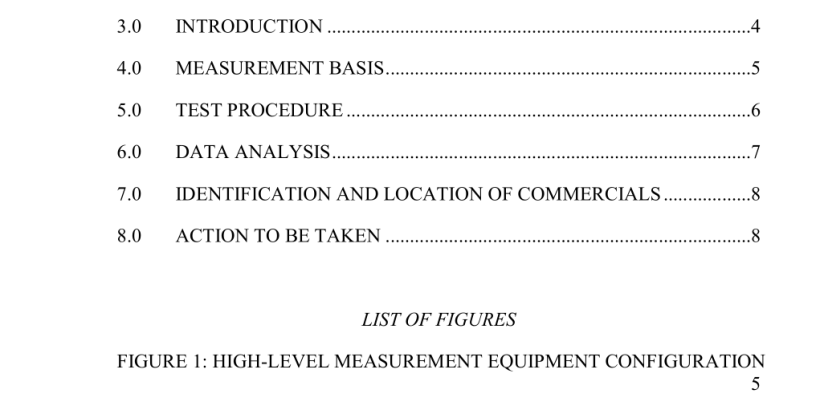ANSI SCTE 197-2018 pdf download.Recommendations for Spot Check Loudness Measurements
6.0 DATA ANALYSIS
In general, the operator is able to monitor and log loudness measurements of 24 hours of continuous programming but may not know which portions are commercials and which portions are long form programming. Consequently, the operator should analyze the logged results to determine if there are any periods of content which potentially are non-compliant with A/85 [1], then determine whether those periods occurred during a commercials. The steps are as follows:
1. Compare each recorded measured loudness value for the 24-hour period with the transmitted dialnorm recorded for that measurement.
2. Process the data to determine if a collection of measurements, taken together indicate there was a significant period (i.e., comparable to lengths of the commercials in the source) where the loudness exceeded the loudness metadata value ( dialnorm for AC-3). The processing method is expected to vary by entity and to evolve with experience, hence none is recommended. Techniques may include averaging, voting, volatility analysis, sample processing, or others.
3. If a period of measured loudness exceeds the dialnorm value for a significant period by more than the criteria 3 defined by the operator, note this as a potential discrepancy by a commercial and note the magnitude, time and duration of the apparent excess loudness. Such discrepancies may be legitimate over short periods for all content and may occur over longer periods for some forms of long form programming, but are an indication of a potential loudness discrepancy of a commercial.
4. Identify whether the potential discrepancy occurred during a commercial (see Section 7).
7.0 IDENTIFICATION AND LOCATION OF COMMERCIALS
Operators should adopt a method for determining whether periods of discrepancy between measured loudness and the loudness metadata value ( dialnorm for AC-3) occurred during short form programming (commercials/promotions). Some methods for determining whether the discrepancy occurred during a commercial or promotional spot might be:
• Request a program log from the programmer, and compare the times of the discrepancy with the program log
• Create a program log by using SCTE 35 messages (recognizing that not all commercials are signaled with SCTE 35 messages), and compare the times of the discrepancy with the program log
• Record thumbnail video at the same time that the loudness measurements are being made,and then manually review the video frames that were captured at the times of loudness discrepancy
• Use Automatic Content Recognition to determine the content of the program at the time of loudness discrepancy
8.0 ACTION TO BE TAKEN
Operators should develop a criterion for the duration and magnitude of discrepancy between loudness and the loudness metadata value ( dialnorm for AC-3) , or other criterion, that triggers a formal contact with the program network in case such notification is warranted by any non- compliance with A/85 [1] for commercials or promotional content governed by spot check regulations. In some circumstances, it may be necessary to carry out further tests over the duration of the specific commercial to determine whether or not the commercial complied with A/85 [1]. In general, discrepancies above an operator-defined criterion should be addressed via a technical discussion with the program network.
This phrase means that there may exist valid reasons in particular circumstances when the listed behavior is acceptable or even useful, but the full implications should be understood and the case carefully weighed before implementing any behavior described with this label. “MAY” This word or the adjective “OPTIONAL” means that this item is truly optional. One vendor may choose to include the item because a particular marketplace requires it or because it enhances the product, for example; another vendor may omit the same item.ANSI SCTE 197-2018 pdf download
